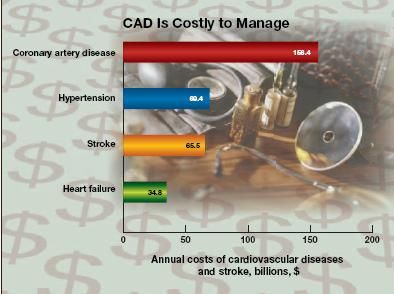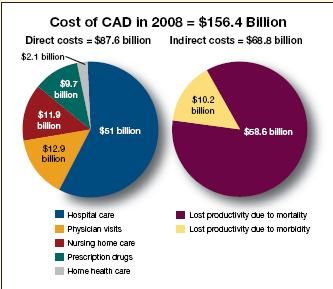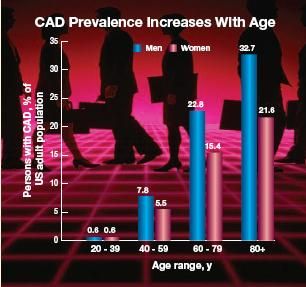Coronary Artery Disease Costs $156.4 Billion Annually
Coronary artery disease (CAD), the most common form of cardiovascular disease in the United States, is the most costly type of cardiovascular condition to manage, according to the American Heart Association. Of the estimated $448.5 billion in total costs for cardiovascular diseases and stroke in 2008, CAD accounted for $156.4 billion, more than twice the cost of hypertension ($69.4 billion) and stroke ($65.5 billion) (Figure 1). Direct costs associated with CAD were $87.6 billion in 2008, of which prescription drug costs alone were $9.7 billion (Figure 2). Of the $68.8 billion in indirect costs for CAD in 2008, $58.6 billion were associated with lost productivity caused by increased mortality.
Coronary artery disease (CAD), the most common form of cardiovascular disease in the United States, is the most costly type of cardiovascular condition to manage, according to the American Heart Association. Of the estimated $448.5 billion in total costs for cardiovascular diseases and stroke in 2008, CAD accounted for $156.4 billion, more than twice the cost of hypertension ($69.4 billion) and stroke ($65.5 billion) (Figure 1). Direct costs associated with CAD were $87.6 billion in 2008, of which prescription drug costs alone were $9.7 billion (Figure 2). Of the $68.8 billion in indirect costs for CAD in 2008, $58.6 billion were associated with lost productivity caused by increased mortality.

Figure 1. In 2008, the total costs of coronary artery disease were more than double those of hypertension and stroke. Source: American Heart Association. Heart Disease and Stroke Statistics-2008 Update.

Figure 2. In 2008, total costs associated with coronary artery disease (CAD) were $156.4 billion, up from $129.9 billion in 2003. Source: American Heart Association. Heart Disease and Stroke Statistics-2008 Update.
CAD is the leading cause of death in the United States, responsible for 1 in every 5 deaths. While the CAD mortality rate declined by 33% between 1999 and 2004-of which 47% is attributable to more effective treatments (eg, antihypertensive and lipid-lowering primary prevention therapies) and 44% is attributable to changes in risk factors (eg, lower total cholesterol levels, lower systolic blood pressure readings)-this figure was adversely affected by increases in average body mass index and diabetes prevalence, which accounted for 8% and 10% increases in the number of CAD-related deaths, respectively.
In 2008, 16 million persons in the United States are estimated to have CAD, up from 12.9 million in 2003. More men (8.7 million) than women (7.3 million) have CAD, and its prevalence increases with age (Figure 3).

Figure 3. Prevalence of coronary artery disease (CAD) is highest among US adults 60 years and older. Source: American Heart Association. Heart Disease and Stroke Statistics-2008 Update.